
|
Chicago Glider Club is located on Bell Road in Minooka, Illinois, about one mile north of US Highway 6. This is about 2 miles SE of Minooka, 9 miles E of Morris, and 8 miles SW of Joliet (about 2 miles SW of the intersection of I-55 and I-80). From Bell Road, turn East onto Airport Road; this road runs immediately along side the grass runway, so please drive with caution and look out for gliders and tow planes. The clubhouse phone is 815-290-5021. |
|
Use the interactive Google map below to see our location. |
Club Objectives |
|
The purpose of the Club is to provide fellowship, information, instruction, stimulation, and education for those interested in flying, gliding, and soaring, both locally and cross country. The Club promotes interest in soaring both locally and on wider levels. The Club supports recognition of outstanding accomplishments in personal feats, sailplane design, and technical advancements pertaining to soaring. CGC has a good blend of flying personalities. Many members just fly locally. But there are about 20 who fly cross country at every opportunity. Flights up to 350 miles have been flown from the CGC Field. For those wishing to start soaring cross-country, or to just improve their thermalling ability, there is a large pool of very experienced soaring pilots from which to obtain advice. After the flying is finished for the day, the cross-country pilots expound on their flight to all who will listen. This often culminates in a cookout by any and all who care to stay. Planned social events include a buffet dinner in the Spring and a Pig Roast in the Fall. |
Membership Obligations |
|
The Chicago Glider Club is a working glider club, not simply a flying club. The club owns the airport, hangers, gliders, tow-planes, and other airport facilities. Club members perform all maintenance activities, including cutting the runway, sweeping out the hangers, and performing annual inspections of the club aircraft. New members are expected to pitch in and assist with all these tasks. The cost of operation is kept to a minimum by having the membership do ALL of the required work to maintain the club. This includes maintaining the aircraft and facility equipment, mowing the grass on the runway, and cleaning the clubhouse. Members participate as their own talents, interest and time permit. This "do it yourself" philosophy is the mainstay of the club and is expected of each member. No work details or schedules are mandated. Each member is expected to share in the work. Being a member can be a real hands-on total aviation experience! Many members are high time soaring pilots and several have extensive contest experience. |
Eligibility |
|
The club always welcomes individuals interested in becoming committed members that love soaring and who intend to participate in the club's operations and activities on a long-term basis. It is preferred that new members have at least a private pilot certificate with any rating; non-glider rated private pilots are welcome. If you need transition training for a glider rating, that can be worked out with a club instructor using club sailplanes to acquire the required experience in preparation for the FAA check-ride. Club instructors offer their service free of charge to club members in club equipment. Any person who expresses an interest in soaring may apply for pilot membership by the payment of the initiation fee and submission of the Club application. Applications for membership in the Chicago Glider Club will be reviewed the Board of Directors for final approval. Applicants must have a sponsor: a sponsor is a current member of the club who is knowledgeable of club procedures and is willing to provide any guidance the new member should require until familiar with club procedures. Although CGC is not set up as a primary glider flight school, the club will consider genuinely committed student pilot applicants. In this case, the student pilot applicant must make prior arrangements with a qualified club instructor for the flying lessons needed to acquire a glider pilot certificate. Family Membership is available at a very nominal one time charge. This enables any member of the regular pilot's family to use club aircraft. The only restriction is that only one club sailplane may be used by the Family Member unit at the same time. This rule is waived on days of low utilization of club sailplanes. All usage fees incurred by family members are the responsibility of the primary pilot member. |
The Application Process |
| Pilots interested in joining the club should contact the club's This email address is being protected from spambots. You need JavaScript enabled to view it. who is in charge of new member relations. The VP will send you an application kit that explains the club's history, and what the club expects from new members. An application form will be included in the application kit. |
The Chicago Glider Club prefers to trust the individual pilot's judgment in contrast to generating a number of definitive rules. However, the following policies are expected to be followed:
Aerotow Procedures
FAR 91 .309(a)(5) requires that before conducting aerotow operations, the pilots of the towing aircraft and the glider "have agreed upon a general course of action, including takeoff and release signals, airspeed, and emergency procedures for each pilot."
Chicago Glider Club pilots have tacitly agreed to such procedures through Club practices, safety seminars, and discussions with tow pilots and glider pilots, thus not delaying towing while such matters are discussed before each flight.
To ensure compliance with the applicable regulation, and to make sure that everyone is following the same procedures that govern CGC towing operations, whether such operations occur at CGC Field or on retrieve from another location, these procedures are set out below.
Should other procedures be more appropriate, any variance will be agreed upon by both tow pilot and glider pilot prior to commencing such tow, or by radio when airborne. Responsibility for determining the appropriate procedures remains with the pilots involved, based on their review of the relevant circumstances.
- The standard signals for ground and on-tow operations arc those listed in the SSA Soaring Flight Manual, and will apply. Each member has reviewed these signals, is familiar with them, and will use them.
- The glider pilot is responsible for arranging for a wing runner, if one is to be used, and for briefing the wing runner as necessary for safe operations.
- Unless directed otherwise by the glider pilot, the tow pilot will tow the glider until it releases, or until 3,000 feet AGL is reached. Upon reaching 3,000 feet AGL, the tow pilot will level off and wait for the glider pilot to release or for an instruction from the glider pilot. The glider pilot will inform the tow pilot, either by ground signal or radio prior to or after takeoff, of any variance from this procedure that he or she desire(s).
- The glider pilot will advise the tow pilot prior to takeoff or by radio if a tow to a specific location or if maneuvering outside the normal high-tow position is intended.
- Tow airspeeds will not be less than 60 knots (70 mph) for fiberglass gliders and 55 knots (65) mph) for other gliders.
- The glider wing will not be raised until the glider pilot signals ready for takeoff.
- The following emergency procedures will apply:
- ... In the event of a power failure while the tow plane is on the ground or at an altitude from which an immediate landing on the takeoff runway is possible, both glider pilot and tow pilot will attempt to release, the tow plane pilot will attempt to move to the left side of the runway and the glider pilot to the right side.
- ... In the event the tow plane pilot notices something is wrong with the glider, such as the spoilers are open, he/she will advise the glider pilot by radio and continue the tow to at least 2,000 AGL (if possible) while returning to over or near the glider field prior to signaling the glider pilot to release.
- ... In the event any other emergency or distracting occurrence arises while in flight that makes aerotow difficult or impossible (such as canopy opening, instrument malfunctions, or the like), the tow pilot will attempt to reach a safe altitude so as to increase the time available to deal with the problem.
CHICAGO GLIDER CLUB BOARD OF DIRECTORS Revised: April 12, 2015
Use of Club Sailplanes for Cross-Country Flights
POLICY:
Use of club gliders for cross-country flying by qualified members is strongly encouraged.
For cross country flight, "qualified" means a member must not only be capable of conducting the flight competently, but he must have ensured that he has a capable retrieve crew in place, whether by aerotow or trailer. (See the guidelines below.)
Each pilot is the judge of his/her competence to attempt a given cross-country flight. However, a member should seek counsel of a club instructor who has cross-country experience before attempting his/her first few cross-country flights. Failure to do so would indicate poor judgment.
Please see the Glider Reservation Policy for the details of reserving a glider for cross- country flights.
REQUIREMENTS:
The board has established these minimal requirements:
- Though no minimum flight time in a specific club glider is required, a pilot shall have made a minimum of three tows and landings in that glider before he/she may use it for a cross country flight. This requirement stands regardless of the member’s other experience.
- The pilot is required to advise another club member, at the club site, of the intention to fly a cross-country flight on that day. A note on the wall near the sign-up board will notify others the glider may be unavailable the rest of the day.
- Gliders returned to the field on the trailer shall be assembled and hangared appropriately and the trailer returned to its appointed spot and tied down properly.
GUIDELINES:
If you plan to have an aerotow back from a landing at another airport, you shall arrange to have a willing tow pilot available for the retrieve.
Since an outlanding is possible, you shall:
- Be able to conduct the assembly and disassembly as well as trailer loading and hookup. You are expected to have actually done it, preferably more than once.
- Prior to departing on a flight, arrange for the correct trailer and adequate, compatible tow vehicle. Good judgment would insist this combination be tested to ensure all components such as lights, tires, trailer hitch, etc., are in operating condition. The retrieve crew must know the location of the keys to the car.
- Recruit a crew capable of retrieving you. For the 2-place sailplanes, more than one crewperson should be recruited. The crew must be able to find, identify, hook up, and bring the correct trailer and all pieces of necessary gear to the retrieve site. Also, you should have necessary maps and charts as well as a communications method (cell phone, radio, etc) in the tow vehicle to ensure directions to the landing site can he passed to the crew.
CHICAGO GLIDER CLUB BOARD OF DIRECTORS Revised: March 2, 2006
Reservation of Club Sailplanes
- Club gliders are reserved on the board located near the clubhouse door on the south wall of the hanger. The board is marked with time slots for each glider.
- Glider reservation is on a "first come-first served" basis. The first member to sign up has their choice of time slots. It is not allowable to reserve multiple time slots (except as allowed by the cross-country policy). After landing from the first flight, any open slots are then available for reservation. Time slots may not be reserved on any previous day, unless the board has approved taking the glider away from our field (to a contest, for example).
- A club member may not reserve consecutive time slots on any one glider for local flying. Two individual club members (but not two members of the same family membership) flying a two-place glider may reserve consecutive slots and need not land between slots.
- The time period between slots is intended for transfer of the glider to the next user. Each user must have the glider on the runway by the end of their reserved time slot so that the next user can be ready for tow when their time slot begins.
- a) If the previous user runs into your time slot, you have been wronged. By all means discuss it with him or her, but your time is still up at the end of your time slot.
- Quite often, the glider usage is not heavy. Notwithstanding all of the above, you may fly as long as you like, provided that you can determine that no one wants the glider. It is fair to make a radio call and have someone at the clubhouse check for you, but it is your responsibility to be sure that no one is has signed up for the glider you are flying. If you can't verify that no one has signed up for the glider, then you must assume that someone has and land before your time is up.
- All of the gliders now have radios and we need to keep the base station active whenever anyone is flying. Likewise the glider radios should be on while you are flying. If you sign up for a time slot while someone else is in the air, it is courteous to contact him or her by radio to let them know that you will be waiting.
- The Discus CS, the Duo-Discus and one ASK-21, may he reserved for cross-country flights by writing your name and "Cross Country" down the time slot column through the time for which you plan to fly. Please refer to the Cross-Country Policy to insure that all responsibilities for cross-country flights have been fulfilled. Only one of the two-place ASK-21 gliders can be signed up for cross-country at a time.
- Cross-country flights can be SSA/FAI Badge flights, record attempts, NISC race flights or flights away from the glider club field chosen to be appropriate for the skill level of the member pilot.
- It is important to remember that the gliders are owned and are to be shared by all members. The cross country reservation policy should be used with care to make sure that members who want to use the gliders have a fair chance to do so. However, there is no set limit to the amount of flying that a member is allowed to do (including cross-country). The idea is to have the gliders being flown - not sitting in the hanger.
- Re-lights are allowed, but if it becomes obvious that you can’t complete your task, you must release the glider for use by the other members.
CHICAGO GLIDER CLUB BOARD OF DIRECTORS Revised: April 1, 2019
Minimum Pilot Requirements For Flying or Towing as Pilot in Command in CGC Powered Aircraft
TO FLY CGC POWERED AIRCRAFT:
- Possess at least a Private Pilot Certificate
- Minimum of 250 hours Pilot in Command in powered aircraft, and;
- Minimum of 50 hours PlC in ASEL with tailwheel, and;
- At least 10 takeoffs and landings in same make and model (Husky and/or Pawnee as applicable), and;
- Checkout by CGC Check Pilot
TO TOW IN CGC POWERED AIRCRAFT:
- Possess at least a Private Pilot Certificate
- Minimum of 500 hours Pilot in Command in powered aircraft, and;
- Minimum of 100 hours PlC in ASEL with tailwheel, and;
- At least 10 takeoffs and landings in same make and model (Husky and/or Pawnee as applicable), and;
- At least 10 tows while accompanied by an "Authorized Pilot"
- Checkout by CGC Check Pilot
A pilot not meeting the requirements, MAY be able to fly the airplanes, by being listed as a "named pilot" on the insurance policy after application through the CGC Operations Officer to the insurance company and meet certain requirements as prescribed by the insurance company.
Qualified CGC Pilots are not required to hold a Commercial Pilot Certificate to tow CGC members.
CHICAGO GLIDER CLUB BOARD OF DIRECTORS Revised: March 27, 2006
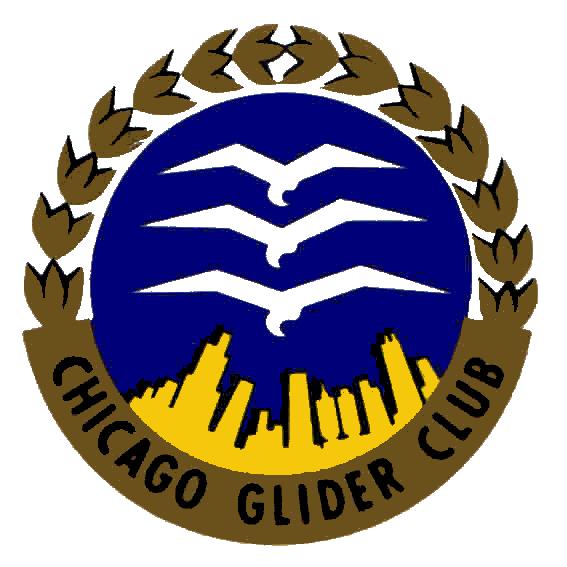 |
Click to order CGC Apparel and Accessories at Lands' End |
The Chicago Glider Club has an active membership of about 80 pilots involved in all aspects of the sport, from instruction through to participation in local, Regional and National soaring contests.
Founded in 1953, we own and manage all of our facilities: our grass runway, hangars and clubhouse were all constructed - and are now maintained - by dedicated and highly proficient members who take pride in the club.
We own a fleet of high quality sailplanes and towplanes that provide economical soaring to club members; many members also own their own sailplanes and base them at the CGC gliderport.
CGC 500K Club |
|||||||||||||||||||||||||||||||||||||||||||||||||||||||||||||||||||||||||||||||||||||||||||||||||||||||||||||||||||||
| The following members have made a cross-country soaring flight of at least 500 km from the Chicago Glider Club's normal field of operation: | |||||||||||||||||||||||||||||||||||||||||||||||||||||||||||||||||||||||||||||||||||||||||||||||||||||||||||||||||||||
|
|||||||||||||||||||||||||||||||||||||||||||||||||||||||||||||||||||||||||||||||||||||||||||||||||||||||||||||||||||||
Boom-a-Rang Contest |
|||||||||||||||||||||||||||||||||||||||||||||||||||||||||||||||||||||||||||||||||||||||||||||||||||||||||||||||||||||
| The Boom-A-Rang contest is a task set in the shape of a boomerang. It starts at the club field and goes to TP1, back to the club field, then on to TP2, with a finish at the club field (hopefully). TP1 and TP2 are defined on the contest day in relation to the weather. This task is held in conjunction with the club's annual Pig Roast. Since this event is held in late September to early October, the task distance is usually rather short (35-50 miles). The following members have won the annual Boom-A-Rang contest. The speed listed is a handicap speed using the SSA Handicap list. | |||||||||||||||||||||||||||||||||||||||||||||||||||||||||||||||||||||||||||||||||||||||||||||||||||||||||||||||||||||
|
|||||||||||||||||||||||||||||||||||||||||||||||||||||||||||||||||||||||||||||||||||||||||||||||||||||||||||||||||||||
|
The club owns its own grass runway, two large hangers, a clubhouse, and a large grass area for trailer tie-down and sailplane assembly. The clubhouse has a large general area, two rest rooms with showers, and a kitchen. Construction of the runway, clubhouse, and hangers was accomplished by volunteer workers from the membership. The only professional help used was to pour the concrete for the large hanger and clubhouse floors. |
 |
| The runway is a grass strip about 300 feet wide and about 1800 feet long with an east-west orientation. On the north side of the property near the east end is the fully equipped clubhouse and 2 hangers. | 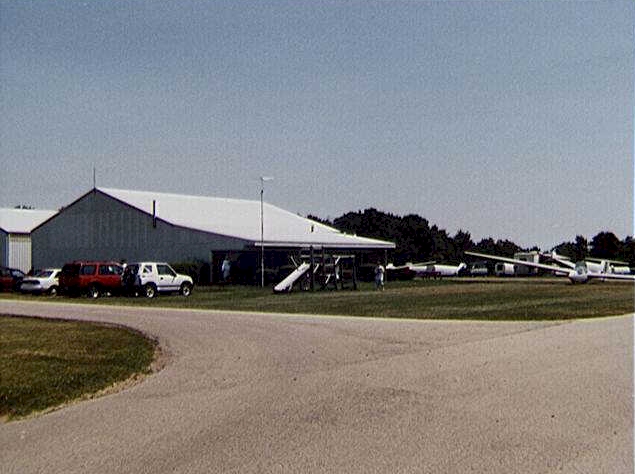 |
| Adjacent to the east side of the hangers is a large grass area used for trailer tie-down and sailplane assembly. | 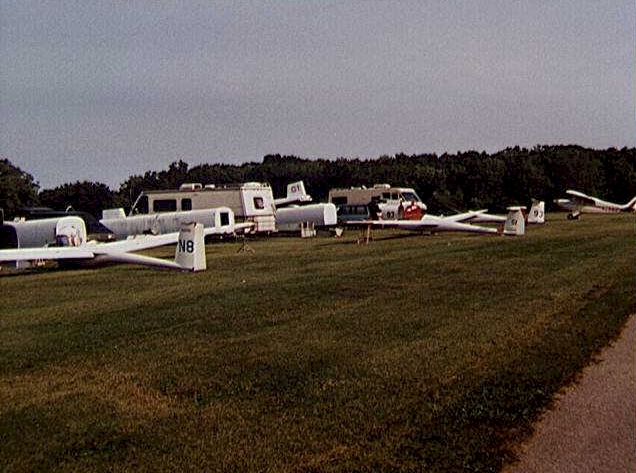 |
| The inside of the clubhouse has a large general area, two restrooms with showers, and a fully equipped kitchen. | 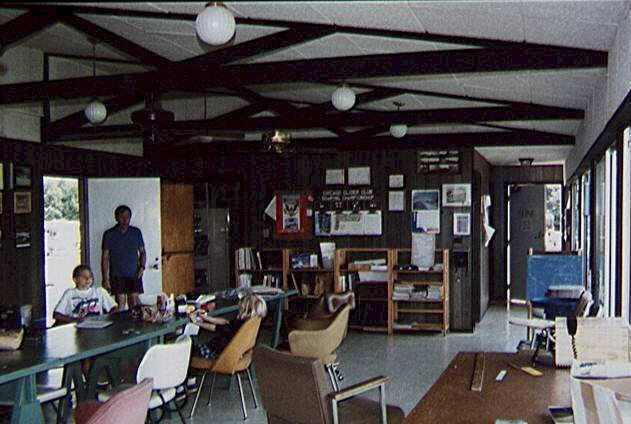 |
|
The Chicago Glider Club was formed in 1953, as evidenced by this announcement that our local historian Simine Short found in the National Soaring Museum in 1998. As described in the announcement (see text below the illustration), CGC was formed by a small group of members from the Chicagoland Glider Council, which had already been in existence since 1937. |
||
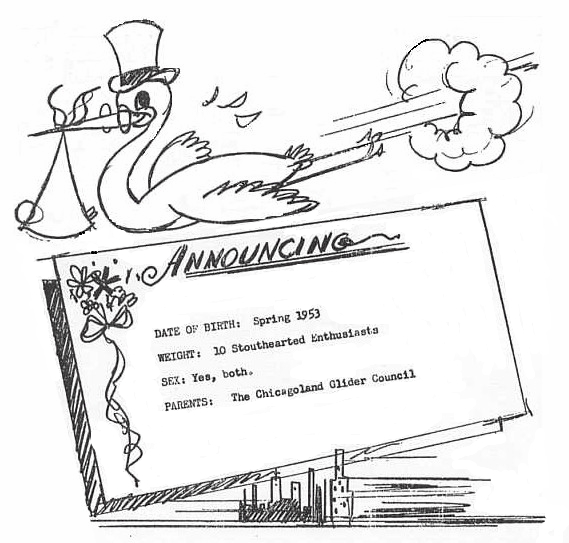 |
||
|
A NEW CLUB IS BORN! The Chicago Glider Club is not to be confused with the Chicagoland Glider Council. It is composed of members of the Council who wish to actively participate in the flying of gliders Those who are now activating the organization are as follows: Mr. and Mrs. James Ducy Julian Hall
Cyril Rogers Millard Wells
Bob Mouroski Allen Schultz
Joe Trefney George Ott
Richard Hawker Sue Yager
Pat Heraeg Bernie Mossberg
The Club has been formed around a Schweitzer TG3 owned by Bob Mouroski and Joe Trefney. The Chicagoland Glider Council and the Chicago Glider Club both wish to extend their gratitude to both of these men for making this ship available to them. The purpose of this Club is to encourage the art of soaring flight in the Chicagoland area. The Council is most pleased with the interest and enthusiasm with which this new venture has been met. If this Club is as successful as it promises to be, other gliders will undoubtedly be made available under this plan for all those who wish to fly them.
|
||
|
|
||
Page 2 of 2

